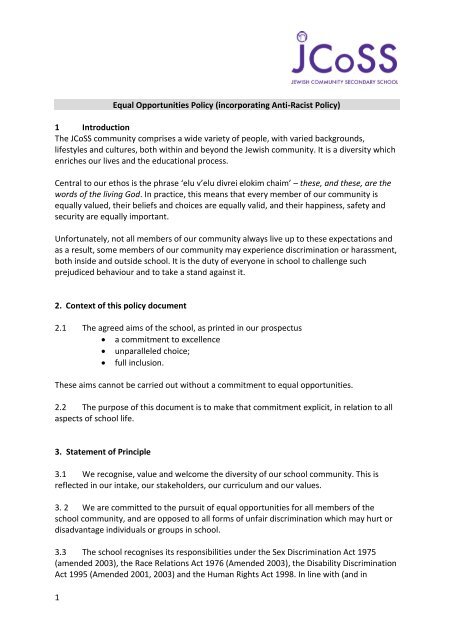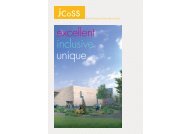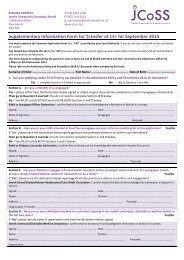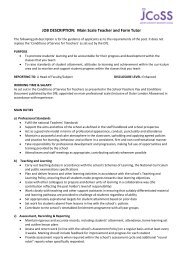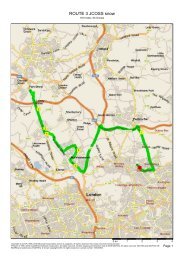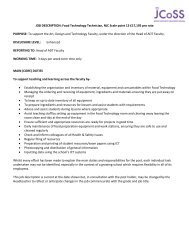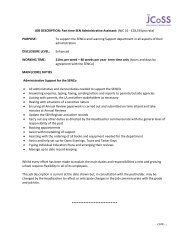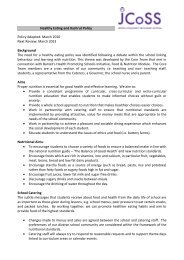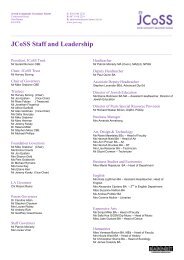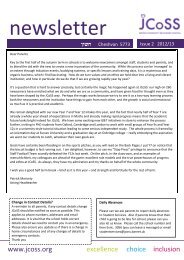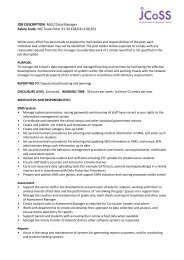1 Equal Opportunities Policy - Jewish Community Secondary School
1 Equal Opportunities Policy - Jewish Community Secondary School
1 Equal Opportunities Policy - Jewish Community Secondary School
You also want an ePaper? Increase the reach of your titles
YUMPU automatically turns print PDFs into web optimized ePapers that Google loves.
<strong>Equal</strong> <strong>Opportunities</strong> <strong>Policy</strong> (incorporating Anti-Racist <strong>Policy</strong>)<br />
1 Introduction<br />
The JCoSS community comprises a wide variety of people, with varied backgrounds,<br />
lifestyles and cultures, both within and beyond the <strong>Jewish</strong> community. It is a diversity which<br />
enriches our lives and the educational process.<br />
Central to our ethos is the phrase ‘elu v’elu divrei elokim chaim’ – these, and these, are the<br />
words of the living God. In practice, this means that every member of our community is<br />
equally valued, their beliefs and choices are equally valid, and their happiness, safety and<br />
security are equally important.<br />
Unfortunately, not all members of our community always live up to these expectations and<br />
as a result, some members of our community may experience discrimination or harassment,<br />
both inside and outside school. It is the duty of everyone in school to challenge such<br />
prejudiced behaviour and to take a stand against it.<br />
2. Context of this policy document<br />
2.1 The agreed aims of the school, as printed in our prospectus<br />
a commitment to excellence<br />
unparalleled choice;<br />
full inclusion.<br />
These aims cannot be carried out without a commitment to equal opportunities.<br />
2.2 The purpose of this document is to make that commitment explicit, in relation to all<br />
aspects of school life.<br />
3. Statement of Principle<br />
3.1 We recognise, value and welcome the diversity of our school community. This is<br />
reflected in our intake, our stakeholders, our curriculum and our values.<br />
3. 2 We are committed to the pursuit of equal opportunities for all members of the<br />
school community, and are opposed to all forms of unfair discrimination which may hurt or<br />
disadvantage individuals or groups in school.<br />
3.3 The school recognises its responsibilities under the Sex Discrimination Act 1975<br />
(amended 2003), the Race Relations Act 1976 (Amended 2003), the Disability Discrimination<br />
Act 1995 (Amended 2001, 2003) and the Human Rights Act 1998. In line with (and in<br />
1
addition to) these Acts, we are opposed to direct or indirect discrimination on the grounds<br />
of:<br />
- disability - age<br />
- - physical appearance - socio-economic status (class)<br />
- - religion and ethnicity<br />
- marital status<br />
- sexual orientation - trade union activity<br />
- HIV-positive/AIDS status - Supremacism<br />
- <strong>Jewish</strong> status as a result of descent or conversion<br />
- Gender<br />
3.4 As a school we aim to achieve an environment in which:<br />
every pupil:<br />
- is respected and respects others (and this respect is based on both an inherent respect<br />
for difference as well as informed understanding of difference);<br />
- has access to a full curriculum;<br />
- is helped to achieve his/her full potential;<br />
- is not subject to unfair discrimination on any of the grounds mentioned above;<br />
every member of staff and governor:<br />
- is respected and respects others;<br />
- is enabled to work and develop without discrimination on any of the grounds mentioned<br />
above;<br />
every parent and visitor to the school<br />
- is respected and respects others;<br />
- is treated with courtesy and is not subjected to unfair discrimination on any of the<br />
grounds mentioned above.<br />
4. Implementation<br />
4.1 The Governing Body give their support to this policy.<br />
4.2 All procedures for the recruitment, appointment and retention of staff will be in<br />
accordance with the principles set out in this policy.<br />
4.3 The CPD (continuing professional development) programme for all staff will continue<br />
to address equal opportunities issues.<br />
4.4 All subject teachers will be aware of and follow the principles of the Race <strong>Equal</strong>ity<br />
<strong>Policy</strong>, the Anti-racist <strong>Policy</strong>, the checklist for use by Heads of Faculty and the school's<br />
Special Educational Needs <strong>Policy</strong>.<br />
4.6 All incidents of unfair discrimination in school will be taken seriously and will be<br />
dealt with through the school's established disciplinary procedures (for students) or the<br />
Governing Body's approved Grievance and Disciplinary procedures (for staff).<br />
5. Monitoring and Evaluation<br />
2
5.1 The Governors will review this policy regularly and ask the Headteacher for a report<br />
on its implementation.<br />
5.2 Faculties and departments will review their practice annually as part of the SEF<br />
process.<br />
5.3 Established procedures are in place for monitoring the home languages, ethnicity<br />
and special educational needs of students.<br />
Adopted: March 2010<br />
Next Review: June 2013<br />
3
Appendix A – Sample practices to embed our <strong>Equal</strong> <strong>Opportunities</strong> and Anti-Racist ethos<br />
1. Racist, sexist, homophobic, supremacist, and other offensive comments and incidents,<br />
however small, must never go unchallenged or ignored. They will be dealt with quickly.<br />
2. Graffiti will be removed as soon as possible.<br />
3. Complaints by students of racist, sexist, homophobic or supremacist behaviour will be<br />
taken seriously and acted on.<br />
4. All incidents of racist, sexist, homophobic or supremacist behaviour must be reported<br />
through the usual channels.<br />
5. We encourage the parents of all students to meet staff and to visit school. In the<br />
absence of interpreters, we are glad to accept the help of students or family members.<br />
6. Our school uniform is designed to allow alternatives acceptable to different cultural and<br />
religious groups. Kippot are optional for boys and girls; girls may choose to wear a skirt<br />
or trousers; Muslim girls may wear a plain black, white or purple headscarf.<br />
7. Bilingualism is a positive asset and is seen and used as such..<br />
8. Displays in the school will reflect the diversity of the world community, as well as that of<br />
our local community.<br />
9. The curriculum as delivered through faculties will acknowledge, value and, where<br />
appropriate, use the diversity of the students' cultural backgrounds.<br />
10. In selecting materials for use in lessons, we use positive racial, gender and cultural<br />
images. Wherever possible we avoid negative images, unless the purpose is to educate<br />
to the contrary.<br />
11. PSHCE programmes will include opportunities to explore the cultural backgrounds and<br />
practices of all students.<br />
12. <strong>Jewish</strong> Education reflects the religious and cultural diversity of the world community.<br />
13. In assemblies we use positive role models and acknowledge festivals from a variety of<br />
cultures.<br />
14. We encourage the inviting of visitors from a wide range of backgrounds, to help foster<br />
the school's multicultural policy.<br />
15. The Incident Sheet (see Behaviour <strong>Policy</strong>) includes a section to enable the monitoring of<br />
racist and bullying incidents.<br />
4
Appendix B – Sample guidance on anti-racist and anti-sexist material selection<br />
i) Visual Material (including charts, posters, illustrations in books, DVDs, UTubes etc):<br />
1. Does the material realistically reflect the distinctive features of different groups within<br />
and beyond the <strong>Jewish</strong> community?<br />
2. Is the material free from stereotyping and tokenism?<br />
3. Are women and black people portrayed positively and seen in a full variety of roles?<br />
4. When students are shown, do girls play key roles?<br />
5. Does the material, taken as a whole, provide a balanced picture and not focus on the<br />
extremes in other societies? It should not, for example, show only the picturesque and<br />
the exotic, or only a way of life which is rural and technologically unsophisticated.<br />
6. Does the material avoid setting up a past way of life as if it were the norm? (For<br />
example, very few Inuit (Eskimos) now live in igloos).<br />
ii) Texts<br />
1. Does this book avoid encouraging racist and sexist stereotypes and feelings of<br />
superiority based on race and sex? Is the language free from patronising and insulting<br />
terminology? (Some books are littered with references to backward nations).<br />
2. Does the book select its examples of excellence, innovation, etc., from various parts of<br />
the world, including non-western societies?<br />
3. Is the Euro-centric approach avoided?<br />
4. Are the histories of countries and the role of the people, including national leaders, in<br />
developing their own societies accurately presented from their own viewpoint?<br />
5. Are the customs, life-styles and traditions of different cultures presented in a manner<br />
which explains their value, meaning and role in the life of the people rather than as<br />
quaint, peculiar, or exotic?<br />
6. Is the complexity and variety of life shown without simplistic generalisations about<br />
regional and national characteristics<br />
7. Does the book avoid setting up a past way of life as if it were still the norm for that<br />
society or culture.<br />
8. Is the role of women in the life and development of all societies and their place in<br />
history and present-day life adequately presented?<br />
9. Does the book avoid using 'he' and 'man' as all-purpose expressions?<br />
5


